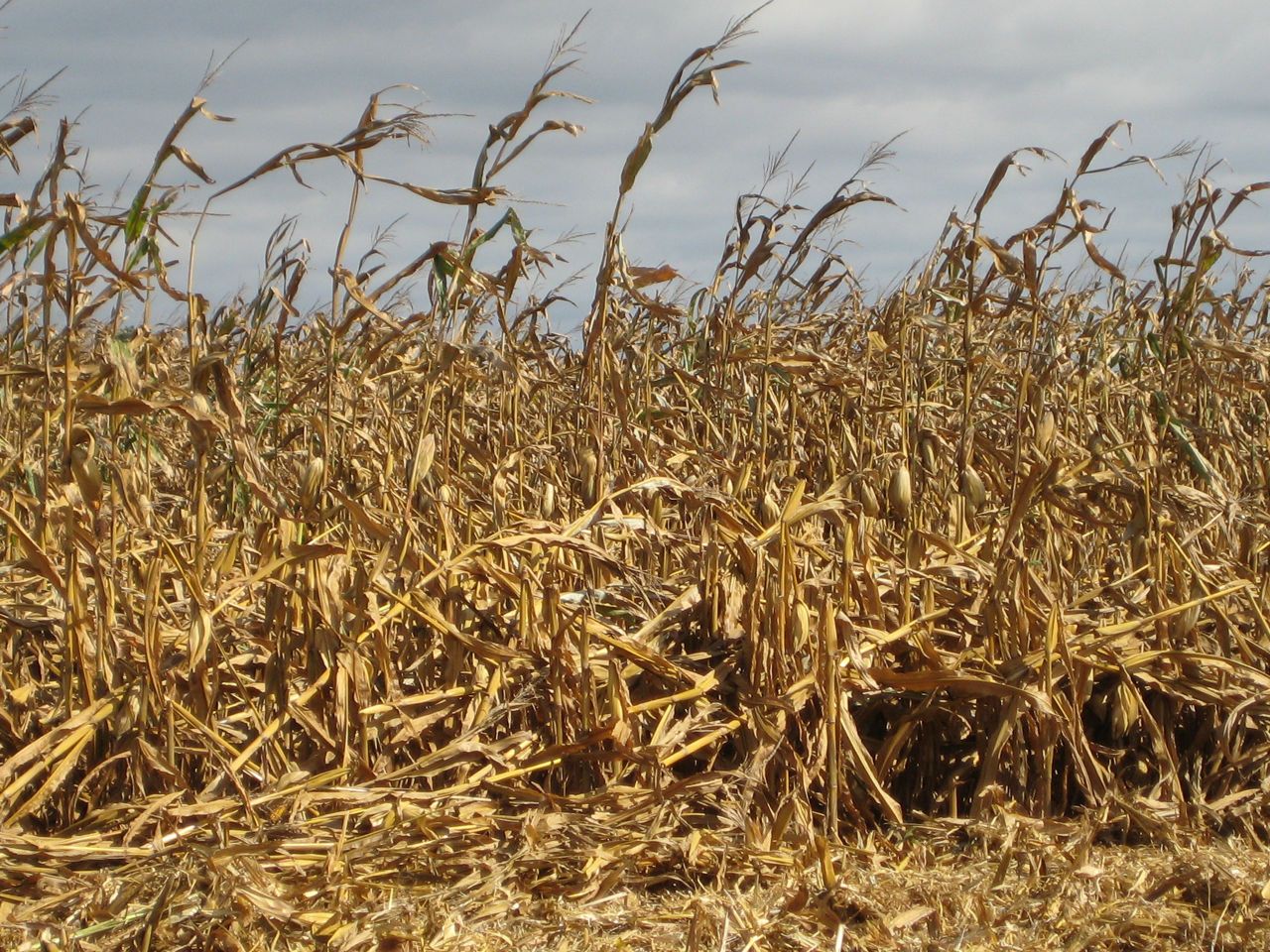Stalk Cannibalization in Corn
June 12, 2021
Stalk cannibalization, remobilization of sugars from the stalks to fill the kernels, resulting in reduced carbohydrate content in the stalks, is the cause of many weakened corn plants that may be found in a field at the end of the season. Cannibalization predisposes corn plants to stalk rots and lodging (Figure 1). Stalk lodging can lead to harvest difficulties that cause yield loss and volunteer corn problems in next year’s crop.

Physiological Stalk Lodging
Physiological stalk lodging is usually the result of an interaction of weather and agronomic factors. Stalk cannibalization can be the result of these interactions as grain fill takes priority over other plant functions. During grain fill in the fall when nitrogen is limiting or exhausted in the soil profile or corn roots can’t take up enough nutrients and water due to dry weather, the plant will begin to pull nutrients and water from the stalks to complete kernel development. The weakened stalks become susceptible to colonization by fungi and either lodge as the result of stalk rot or just weakened stalks. Pathological stalk lodging is caused by the presence of one or more stalk rot diseases. However, many of the lodged corn plants that you find in the fall are the result of physiological stalk lodging and not pathological stalk lodging.1
Conditions Leading to Stalk Cannibalization
Planting delays early in the season due to wet and cool weather along with saturated soils can result in a shallow corn root system.2 Soil compaction, insect feeding, or injury from fertilizer or herbicides can also reduce root growth. Restricted root growth early in the season followed by dry conditions during grain fill can cause the plant to cannibalize nutrients and water from the stalk to nourish developing kernels. Nutrient deficiencies or leaf diseases can reduce green leaf tissue and photosynthesis and can result in stalk cannibalization. Drought conditions or prolonged periods of cloudy weather during grain fill can force the plant into stalk cannibalization to support grain fill. Stalks weakened by cannibalization can lodge prematurely before black layer formation in the event of strong winds and heavy rainfall.
Diagnosis and Management
The level of cannibalization can be identified by splitting stalks and looking at the interior pith. Stalks weakened by cannibalization will have a pith that is white in color with a “styrofoam-like” consistency.3 The closer the cannibalized pith level is to the soil line, the more the stalk is weakened. When stalk rots are present, the diseased pith is often discolored. You should also watch for “droopy” ears where the shank becomes collapsed or crimped. Late season drought stress combined with cannibalization of the ear shank is similar to what happens when the main stalk is cannibalized. If corn ears have not yet reached physiological maturity, collapsed ear shanks can cause kernels to black layer prematurely reducing grain yield. The presence of stalk cannibalization and stalk rots in corn may not always result in stalk lodging, especially if the affected crop is harvested promptly. Corn products also have different stalk strengths. However, a corn product with strong stalks and excellent standability is still prone to lodging due to cannibalization if harvest is delayed and the crop is subjected to strong winds and heavy rain.
Scouting should begin in the early fall to monitor the general health of lower stalks.4 Fields should be scouted separately since the level of stalk cannibalization and rot can vary from field to field and corn product as to their strength and susceptibility to lodging. Particular attention should be given to stalk health in fields that have endured multiple stresses during the year and further stressed by dry soil conditions during grain fill. Push or pinch tests can be used to check for weakened stalks that are prone to lodging. Walking a zigzag pattern through the field, push each stalk about 5 to 8 inches from upright (approximately a 45° angle) and note whether the plant springs back, remains tilted, or breaks. Also, you can test stalk firmness by squeezing or pinching each stalk at one of the lowest nodes above the brace roots. Healthy stalks are firm and cannot be compressed. If a stalk feels soft, it is likely prone to lodging. Check at least 10 plants in each of several locations in a field. If more than 10% of plants exhibit stalk cannibalization or rot symptoms, it is recommended to harvest affected fields first to reduce the chance of plants lodging prior to harvest.5
Fields identified that are clearly high risk for stalk lodging prior to harvest should be scheduled for harvest as early as possible, to reduce the risk of severe lodging relative that could result in harvest losses. Take into consideration that upright corn, depending on stalk strength, is also at risk of lodging. Therefore, it can be challenging to decide when to harvest the downed corn and the upright corn. Knowing the percent of corn that is down or lodged along with the grain moisture can help determine harvest order.
Sources
1Bechman, T. 2013. Weak stalks gave up the ghost for corn crop. Indiana Prairie Farmer. https://www.farmprogress.com.
2Thomison, P. 2019. Watch for corn stalk issues this fall. Ohio State University. Ohio Ag Net. https://ocj.com.
3Thomison, P. and Paul, P. 2019. Stalk quality concerns. The Ohio State University, Agronomic Crops Network. https://agcrops.osu.edu.
4Nielsen, R. 2003. Stalk health issues in stressed corn. Purdue University. Corny News Network. https://www.agry.purdue.edu.
5Bartels, M. and Jackson-Ziems, T. 2020. Check stalk quality of corn going into harvest. University of Nebraska-Lincoln. CropWatch. https://cropwatch.unl.edu.
6005_S15
Seed Brands & Traits
Crop Protection
Disclaimer
Always read and follow pesticide label directions, insect resistance management requirements (where applicable), and grain marketing and all other stewardship practices.
©2024 Bayer Group. All rights reserved.